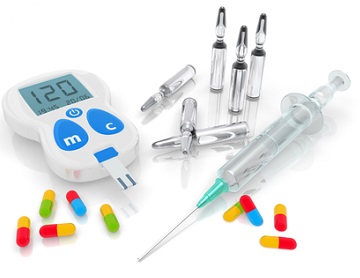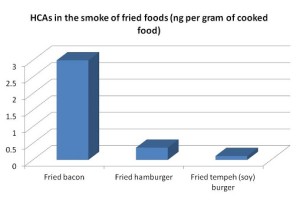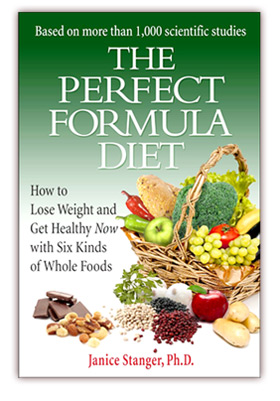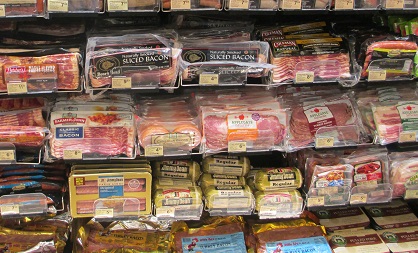
Bacon is a food fad, and so a large selection greets shoppers. Yet few know how really dangerous this product is.
A Toxic Chemical Brew Disguised As Something Edible
The dangers of bacon make this food fad a gateway to cancer and early death. Research shows that processed meats, which include bacon, are health disasters. For example:
• Two studies in the US totaling 121,342 participants found each daily serving of processed meats was linked to a 20% increased risk of premature death
• A study in Europe of 448,568 adults discovered a high consumption of processed meats was associated with a 44% higher death rate
• Swedish researchers found men who ate the most processed meat had a 28% higher chance of developing heart failure, and over twice the likelihood of dying from this condition
Of all processed meats, bacon is one of the most health-destroying, and can rob years from your life in three ways. Here’s how.
One. Eating Bacon
Bacon is a complex stew of dangerous components. A few of the hazardous substances that researchers have discovered in mega amounts in bacon include:
AGEs
Advanced glycation end products (also called AGEs or glycotoxins) are inflammatory, toxic substances that form in large amounts when foods high in proteins and fats are cooked at high temperatures – for example, through frying, grilling, or barbecuing. These substances, which accumulate in your body and make it harder for your tissues to do their job, cause damage that includes oxidative stress, inflammation, and altering your normal protein structure and function.
AGEs are especially dangerous for patients with diabetes, but also give other diseases a leg up. For example, the AGEs that collect in your cartilage make it more likely you will develop osteoarthritis in the affected joint. AGEs contribute to the development of additional chronic illness, including cardiovascular disease, kidney disease, Alzheimer’s disease, cataracts, and erectile dysfunction.
In 2010, the American Dietetic Association published a study showing the amount of AGE units in a serving of 549 foods. Of all items tested, fried bacon had the highest amount of AGEs per ounce.
This means one serving of bacon, at a tiny 13 grams (less than half an ounce) has a massive AGE load of 11,905. Contrast this with (all per 3 and a half ounces of the other foods):
• Canned kidney beans – 191 AGE units
• Apple – 45 AGE units
• Canned corn – 20 AGE units
You would have to eat almost 14 pounds of kidney beans to get the same amount of AGEs as are in one mouthful of fried bacon.
N-NITROSOS AND THEIR CHEMICAL COUSINS
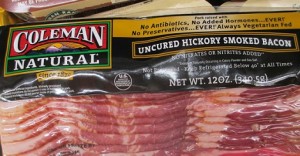
Uncured bacon is not the solution for nitrites and the toxic chemicals that form when these react with proteins
N-nitroso compounds and related chemicals form when nitrites chemically react with proteins or substances derived from protein. These chemicals are potent carcinogens, measurably increasing your chance of developing a wide range of cancers, including those of the liver, gastrointestinal tract, lung, prostate, uterus, pancreas, kidney, and bladder.
Nitrites are added to processed meats, including bacon, to prevent you from developing botulism and other types of food poisoning. Many plants also naturally contain substantial amounts of nitrites, but plants lack the protein density and heme iron (a kind of iron in animal foods) that encourage the nitrites to change into N-nitrosos and related compounds.
A kidney cancer study of 491,841 older adults in six US states shows the results of
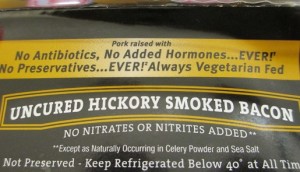
As you can see from the back of the package, companies have to tell you that “uncured” bacon is actually full of nitrites, but from “natural” sources – as if that made any difference
this. Those who ate the most nitrites from processed meats had a 33% high chance of developing this cancer. However, there was no link at all between nitrite from plant sources and kidney cancer.
Like AGEs, N-nitrosos form in massive quantities when protein-dense foods are cooked at high temperatures. Because bacon is usually fried until crispy, it is a concentrated source of N-nitrosos.
Buying “uncured” bacon does little to help. Such “uncured” processed meats have nitrite added from specially formulated celery concentrate, so they really are “cured.”
HCAs
Heterocyclic amines (HCAs) make up another group of cancer-causing substances that form when meat or fish is cooked at high temperatures. HCAs can bind directly to your genetic material, causing it to mutate and produce malignant cells – increasing the likelihood you will develop breast, prostate, skin, lung, liver, pancreatic, or colon cancer.
Meat Science, the official journal of the American Meat Science Association, in a 2012 article called HCAs “potent mutagens,” and measured the amounts of these chemical produced when pork, beef, chicken, and fish were cooked by different methods. This research found that fried bacon had the highest total HCA content of all foods tested.
Two. Breathing Fumes From Cooking Bacon
You will not be surprised to learn that some of the hazardous chemicals just described get into the smoke of frying bacon, making the fumes themselves carcinogenic.
As one example, a group of scientists compared the total amount of HCAs in smoke
condensed from frying three kinds of foods: hamburgers (beef), bacon, and tempeh (soy-based) burgers. The amounts of HCAs in the captured smoke, per gram of cooked food, when each type of food was fried at about the same temperature, were:
• 3 ng/g for bacon
• .37 ng/g for hamburgers
• .177 ng/g for tempeh burgers
Additional harmful chemicals also pervade fumes from cooking meat, making breathing a hazardous activity when bacon is frying.
Three. Getting an Infection
Because bacon is so heavily doused with chemicals, you have a lower risk of developing food poisoning than is the case for many other animal foods. Still, eating bacon can lead to food poisoning if the meat is not adequately cooked, or if the raw meat has contaminated anything else in your kitchen (such as a counter top you then put fruit onto).
However, there is a more subtle way that supporting the pork industry causes

Infections from MRSA can be so serious that they require surgery to cut away the infection that antibiotics can’t touch
infections. Eighty percent of the antibiotics in the US are used on farmed animals. This widespread misuse of drugs for the convenience of industry leads directly to “superbugs,” which are resistant to most antibiotics. The Centers of Disease Control (CDC) estimates these microbes lead to over two million illnesses and 23,000 deaths a year.
MRSA, one of the best-known drug-resistant bacteria, causes 11,000 deaths a year, and has been closely associated with facilities that raise pigs. So by consuming bacon, you are directly supporting the filthy, crowded conditions that produce MRSA and other deadly infections.
Enjoy Other Foods!
What can you eat instead of bacon? Some tempeh products and other plant foods have been formulated to have a flavor and crunch similar to bacon. Beyond this, you are likely craving savory foods with satisfying flavor and a distinctive smell. There are thousands of plant-based recipes available online for healthy meals that are appetizing, with lovely spices and fragrances. You may want to add smoke flavoring to some plant-based recipes. Try the sites fatfreevegan.com or forksoverknives.com to get started, and as you search, you will come up with many more.

How about some delicious colorful raspberries with fresh mint for breakfast, instead of greasy toxic bacon?
In a few short weeks, your taste buds will evolve. Greasy bacon will no longer appeal, especially when you recall it may be robbing you of years of life, putting you at risk for chemotherapy and ambulance rides to the hospital. Judge for yourself if the tradeoff is worth it.
If you enjoyed this post, you may want to check out why fish is another dangerous food.
Intrigued? Now you can use our Whole Foods Blog Finder to target informative, fun postings on whole foods, plant-based diets. Quick information at no cost!
Blog posting by Janice Stanger, Ph.D. Janice authored The Perfect Formula Diet: How to Lose Weight and Get Healthy Now With Six Kinds of Whole Foods, a book that shows you the best whole foods, plant-diet.
Tags: advanced glycation end products, AGEs, bacon, bacon smoke, cancer, Forks Over Knives, HCAs, MRSA, N-nitroso, processed meat
